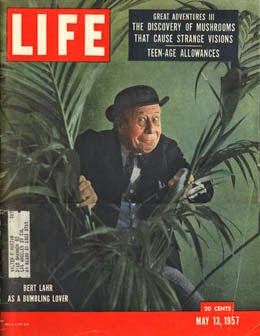An entheogen ("generating the divine within")[4] is a chemical substance used in a religious, shamanic, or spiritual context[5]that may be synthesized or obtained from natural species. The chemical induces altered states of consciousness psychological or physiological (eg bullet ant venom used by the Satere-Mawe people). Entheogens can supplement many diverse practices for transcendence, and revelation, including meditation, yoga, and prayer, psychedelic and visionary art,traditional medicine and psychedelic therapy, witchcraft, magic, and psychonautics.In our modern society many of these substances are better known as hallucinogens or psychedelics. These substances have really only very recently entered the western world as far as wide spread or popular use goes. The first modern instance of westerners participating in the use of entheogens only goes back to 1955, with Valentina and R. Gordon Wasson. The Wassons were actively included in an indigenous mushroom ceremony in Mexico and subsequently published their experience in a 1957 Life Magazine article.
Inspired after reading the article, Timothy Leary and Richard Alpert started the Harvard Psilocybin Project in 1960 to promote psychological and religious study of these mushrooms. They were dismissed by Harvard and decided to turn their focus towards promoting the Psychedelic experience to the hippy counter culture movement. It was, obviously, a roaring success. Mushrooms, LSD, and other psychedelic drugs are still strongly associated with hippy culture due to their widespread use during the 60s, but after the Flower Children grew up it would seem that the use of hallucinogens has dried up. Why?
In 1971, psilocybin and psilocin (the active compound in hallucinogenic mushrooms), along with a slew of other drugs were made illegal during the UN Convention on Psychotropic Substances. This list also includes DET, DMT, LSD, and Mescaline. Almost all of these drugs were Schedule I, or the drugs were considered to create the highest risk to public health. With pretty high penalties regarding the synthesis, sale and possession of the most popular hallucinogenic drugs use of these substances in popular culture started to dwindle and be replaced by other drugs such as cocaine, amphetamines, and party drugs like MDMA in the 80s and 90s. Scientific or medical research on entheogens ground to a halt. Aside from spiritual use with the indigenous tribes who had always used them, the plants and compounds more or less faded into obscurity. People still tried mushrooms from time to time, or acid if they could find it, but the drug culture was shifting away from these spiritual plants.
There is somewhat of a loophole in the scheduling. Currently no plants or plant products are included in the 1971 convention.
Commentary 32-12: It may be pointed out that at the time of this writing the continued toleration of the use of hallucinogenic substances which the 1971 Conference had in mind would not require a reservation under paragraph 4. Schedule I does not list any of the natural hallucinogenic materials in question, but only chemical substances which constitute the active principles contained in them. The inclusion in Schedule I of the active principle of a substance does not mean that the substance itself is also included therein if it is a substance clearly distinct from the substance constituting its active principle. This view is in accordance with the traditional understanding of that question in the field of international drug control. Neither the crown (fruit, mescal button) of the Peyote cactus nor the roots of the plant Mimosa hostilis [Footnote: "An infusion of the roots is used"] nor Psilocybe mushrooms [Footnote: "Beverages made from such mushrooms are used"] themselves are included in Schedule I, but only their respective active principles, mescaline, DMT and psilocybine (psilocine, psilotsin).Commentary 32-13: It can however not be excluded that the fruit of the Peyote cactus, the roots of Mimosa hostilis, Psilocybe mushrooms or other hallucinogenic plant parts used in traditional magical or religious rites will in the future be placed in Schedule I by the operation of article 2, at a time at which the State concerned, having already deposited its instrument of ratification or accession, could no longer make the required reservation. It is submitted that Parties may under paragraph 4 make a reservation assuring them the right to permit the continuation of the traditional use in question in the case of such future actions by the Commission.


the members of this genus have edible seeds. I don’t know if this one has edible seeds or not. When I get better health insurance I’ll find out. Syrian Rue Extract Extracts
ReplyDelete